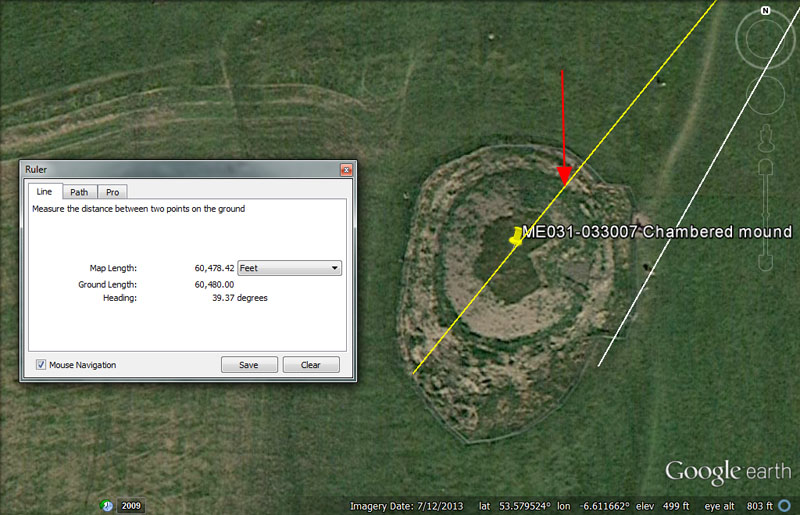
FURTHER MENTION OF THE HILL OF TARA
Because this hill is venerated as the the place where the ancient high kings of Ireland were crowned at the Stone of Destiny or Coronation Stone (Lia Fáil) up until 500 AD, it holds particular historical significance. It is known that the Stone of Destiny stood at the doorway of the Mound of the Hostages at the highest point of the hill, until it was moved a short distance to mark the graves of the 400 fallen Irish defenders who died on the hill during the 1798 uprising against the English.
It stands to reason that the Mound of the Hostages, as it is now called, would have represented a trig or surveying point of paramount importance, as it was built in about 3400 BC and, as a chambered mound, is claimed to predate its Boyne River Valley counterparts, Knowth and Newgrange, by several centuries. By consequence, Dowth Henge must be of an age contemporary with the Mound of the Hostages.

A yellow line extends from the centre of Dowth Henge for 60480' to resolve upon the Mound of the Hostages. The return angle to the henge is 39.375-degrees (39 & 3/8ths).
The red arrow marks the spot of 11.5-miles (of 5250') from Dowth Henge's centre, resolving onto the Mound of the Hostages.
A white line extends from Knowth chambered mound for 51562.5' @ 30.25-degrees return and falls to the eastern edge of the mound near the doorway where the Stone of Destiny stood for thousands of years. This distance is 30000 Egyptian Royal Cubits of 20.625" each. In the 24750-mile reading of the Earth's equatorial circumference, the sum of 515.625-miles (51 & 5/8ths) would be 1/48th part or 7.5-degrees of arc.
Likewise, the Mound of the Hostages sat 201600' (exactly 30 ancient Irish miles of 6720' each) from the cairn atop Slieve Gullion Mountain in County Armagh, with the angle to that summit cairn at 11-degrees. This distance was 1/648th of the equatorial circumference of the Earth or 33 & 1/3rd arc minutes.
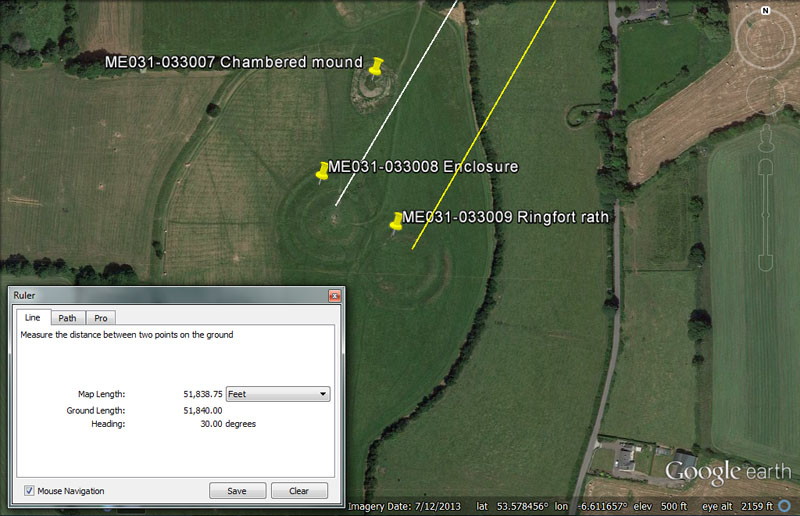
Two lines are shown extending from Knowth chambered mound for 51840', one @ 30.24-degrees return and the other @ 30-degrees return. The slight diagonal offset in the line end points is mirrored by the slight offset of the two rings on the ground. These coded distances and angles were of manifold importance to the ancient architect-astronomer-navigators laying out this dual ringed structure atop the Hill of Tara.
Similarly, lines running from the centre of Newgrange passage mound resolve onto the southern edges of the two enclosures at 51840', showing that both Knowth and Newgrange passage tombs are situated equidistantly from these central structures atop the Hill of Tara.
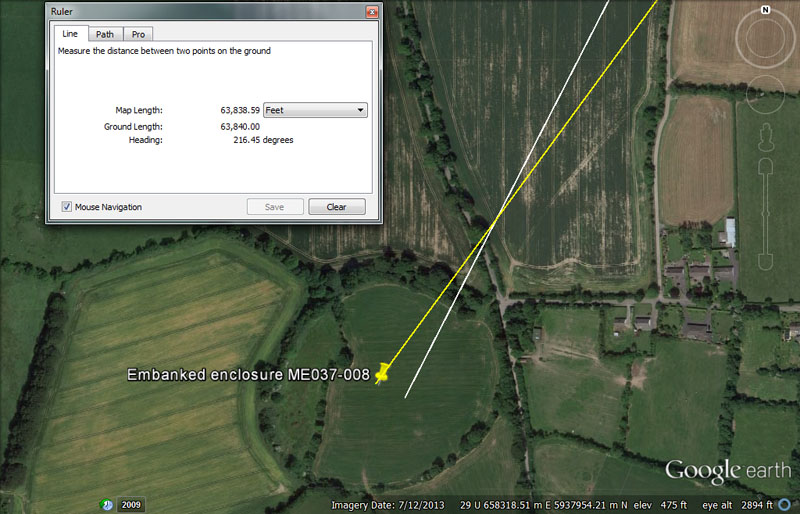
And yet further South within the Hill of Tara complex is this huge embanked enclosure. It sits 10.5 English miles (55440') from Knowth @ 207.36-degrees. From Dowth Henge it sits 9.5 Irish miles (63840') away @ 36.45-degrees return.
This angle value is navigational and relates to the so-called Roman measurement system ... 3645' would be 3750 Roman feet or 750 Roman paces.
Sites that were recently destroyed:
While on the subject of the Hill of Tara structures, it would be appropriate to identify the codes of position for a series of now destroyed sites at the near approaches to the hill, which found themselves in the path of the new M3 motorway in 2007. These included Rath Lugh, as well as a newly discovered souterrain & timber enclosure.
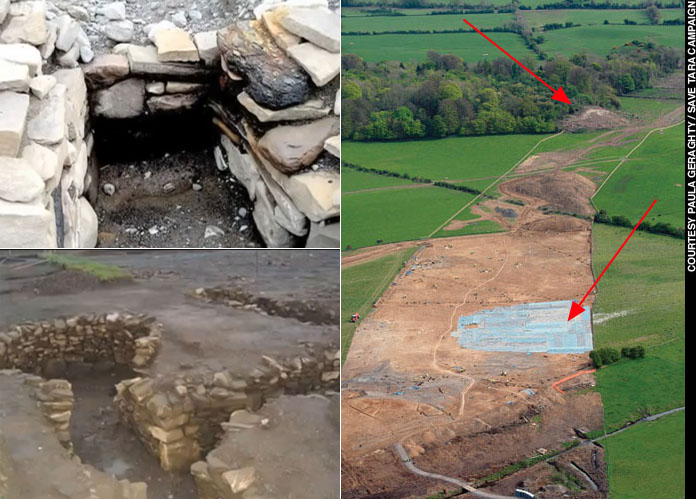
Left: Never to be seen again glimpses of the now destroyed
souterrain, erased when the M3 motorway went over the top of it. Note the
circular beehive chamber for more comfortable and spacious accommodation
Right: The path of destruction. An arrow points to the large blue-grey patch,
which contained a wooden-post henge or enclosure, as well as the souterrain,
each of which now lie under the tarmac. Another arrow points to Rath Lugh,
a part of which was gouged out to accommodate the new motorway.
So, what were the codes of position for these ancient sites?
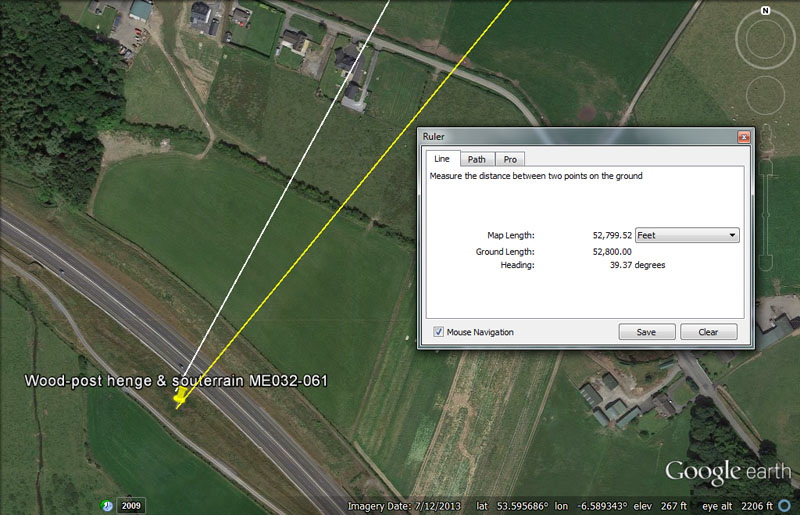
The now destroyed wooden-post henge and souterrain were positioned exactly 52800' or 10 English miles from the centre of Dowth Henge on a return angle back to the henge of 39.375-degrees, or the same, lunar-coded trajectory as the Mound of the Hostages atop the Hill of Tara. From Knowth the distance is 44000' @ a return angle of 28.8-degrees.
There was yet other souterrain accommodation available in the near vicinity, namely ME032-021 in the cliff face a short distance to the NW and ME032-049 to the SSE.
The souterrain in the cliff complies, very closely, to a distance out from the henge of 52500' or 10 so-called Greek miles on an angle of 121-degrees, for a return angle of 41-degrees.
Under the navigational system that uses a mile of 5280', 1-degree of arc is 68.75-miles, for which 121000' (20-minutes of arc) represents 1/3rd of that distance.
Souterrain ME032-049, which sat about 1100' feet away from the now destroyed complex under the M3 motorway, was designed to be 11 so-called Roman miles from Dowth Henge at an angle of 218.4-degrees, for a return angle of 38.4-degrees.
The value 384 was very important to ancient calculations concerning the equatorial circumference of the Earth and 38.4-miles would equate to 1/648th of the 24883.2-mile circumference. Also, at Stonehenge, the encompassing embankments form a slight oval, giving a North to South diameter of 384'.
Some archaeologist speculate that the souterrain structures were not Neolithic-Age, but late Iron-Age or even mediaeval, however, the distance and angle codes inherent in their positions prove otherwise, as does the incised design work on many component boulders. They were most-oft positioned at or near known Neolithic sites as an integral part or appendage to those neighbouring complexes, undoubtedly providing much-needed and very welcome shelter to transient, wayfaring students of the astronomical & navigational arts.
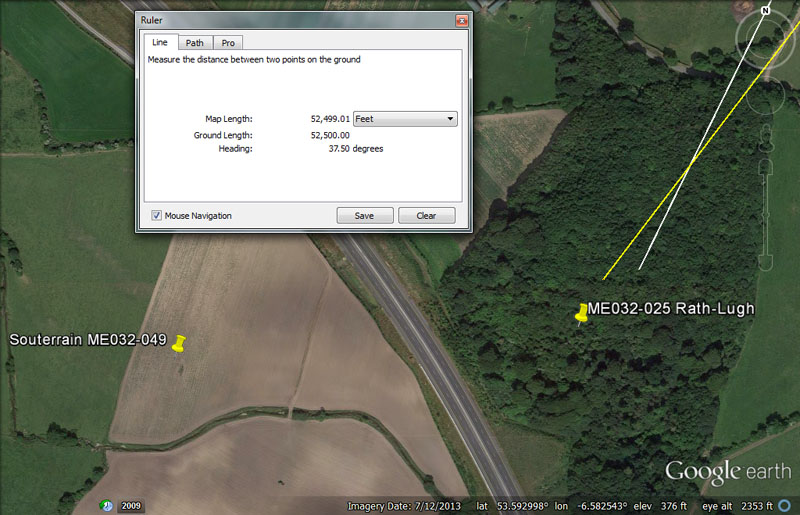
Rath Lugh, which lost its SW edge due to the new motorway sits 44000' (8 & 1/3rd-miles) from Knowth @ 26.4-degrees return. From Dowth Henge it is 52500' (10 so-called Greek miles) @ 37.5-degrees return.
A length of 2640' would be half a mile of 5280'. A length of 375' would be 1/14th of a mile of 5250'.
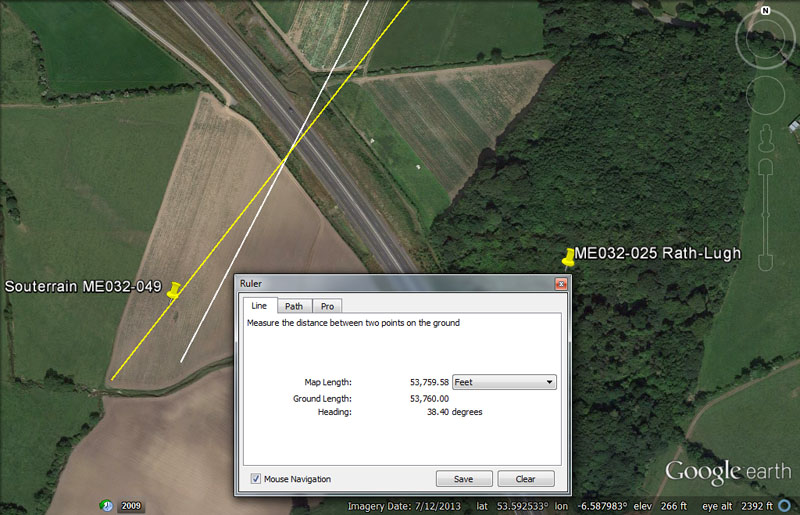
A souterrain that was unaffected by motorway construction sits 45000' from Knowth @ 27.648-degrees (27 & 81/125ths ... related to the equatorial circumference ... 27.648-miles would be 1/900th of the 24883.2 circumference). From Dowth Henge the coded distance was 53760' (1/2430th of the equatorial circumference) @ 38.4-degrees.
A second reading could be 11 Roman miles (53460) which would resolve at the side of the souterrain).